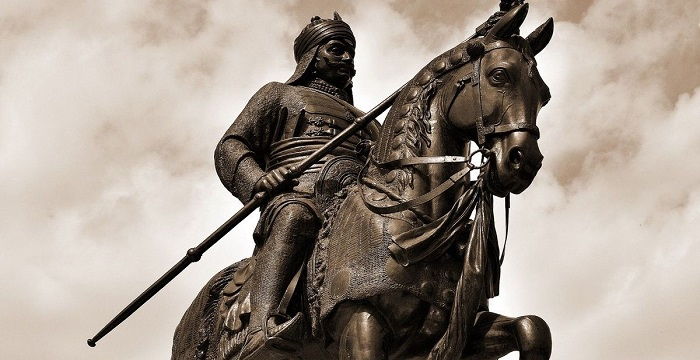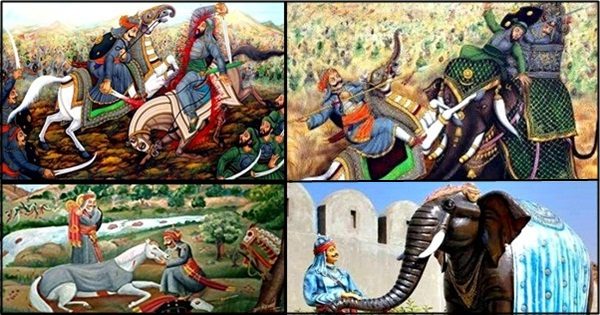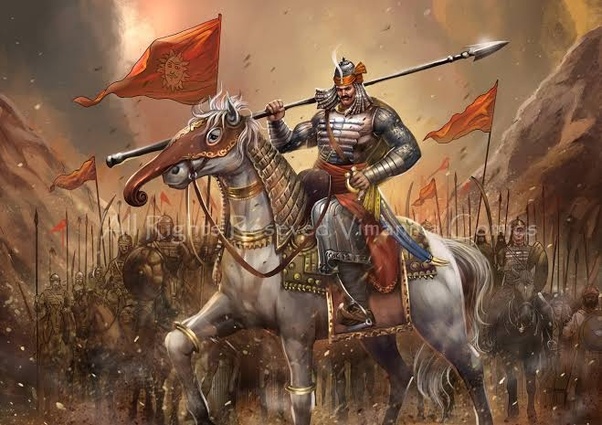Maharana Pratap (9 May 1540- 19 January 1597) is one of the bravest Rajput rulers of India. His original name was “Rana Pratap Singh” popularly known as Maharana Pratap. He was the Hindu Maharaja of Rajput confederacy of Mewar who ruled between 1572 to 1597, now in Northwestern India in the present day state of Rajasthan and eastern Pakistan.
Early Life
Maharaja Pratap belonged to the Sisodia clan of the Rajputs. In the year 1540, Maharana Pratap was born to Uday Singh II of Mewar and Maharani Jaiwanta Bai in Kumbhalgarh, Rajasthan. The same year in which Udai Singh ascended to the throne after defeating Vanvir Singh. He had three younger brothers named Shakti Singh, Vigmal Singh, and Jagmal Singh. His step-sisters are Chand Kanwar and Man Kanwar. His chief consort was Maharani Ajabde Punwar Bijolia.
Accession

Maharan Pratap’s ascension to the throne of Mewar was marred by disputes on who would succeed the throne. Upon the death of Udai Singh in 1572, the eldest son of Rani Dheer Bai Batyani named Jagmal Singh was initially crowned as the heir on her insistence. However, He was soon replaced by senior courtiers due to his incompetence and treacherous inclinations by Maharana Pratap as the rightful king.
This is how, the desire of seniors prevailed and Maharana Pratap ascended the throne of Mewar on 1 March 1572 at the age of 32. He was the 54th ruler of Mewar in the line of Sisodia Rajputs. On the auspicious day of Holi, he was crowned in Gogunda. In this tussle, Jagmal swore revenge and left for Ajmer to join the armies of Akbar. He obtained the town of Jahazpur as a Jagir as a gift in return for his help.
Battle of Haldighati
The siege of Chittorgarh had led to the loss of the fertile eastern half of Mewar to the expansionist Mughal Empire during the reign of Udai Singh II. However, the western half of Mewar which consisted of the wooded and hilly terrain near the Aravalli range was firmly under the control of the Sisodia Rajputs. Mughal Empire Akbar’s intention was to secure a stable route to the economic powerhouse of Gujarat through Mewar. Akbar sent many diplomatic missions to convince Maharana Pratap to become a vassal of the Mughal Empire like the other Rajput rulers in the region had done. But he refused to submit in person to Akbar thus ensuring the battle would be inevitable.

The forces of Mewar and Mughal Empire met on 18 June 1576 at the narrow mountain passes of Haldighati near Gogunda, present-day Rajsamand in Rajasthan. This came to be known as the Battle of Haldighati. The army of Mewar of 3000 cavalry and 4000 Bhil archers faced a Mughal army numbering 5000 and 1000 consisting of Elephants and Musketeers.
The Mughals likely outnumbered the Mewar soldiers by a ratio of four to one, but sources vary on the strength of the two armies. Even though the Mewaris had some early triumphs, the tide eventually turned against them, and Pratap ended up hurt and without a day. Recovering in a rearguard action were some of his men under Jhala Man Singh.
Man Singh was expelled from the Mughal court for a while by Akbar because he failed to pursue the Mewar army during their withdrawal. Maharana Pratap continued his resistance against the mughals through guerilla warfare despite the reverse at Haldighati, and by the time of his death gained much of his ancestral kingdom.
Re-Conquest of Mewar

Maharana Pratap took refuge in the Chappan area. After Jaganath Kachwaha’s invasion of Mewar, the Mughal Empire shifted their focus towards Punjab and other north-western regions due to Rebellions. Maharana Pratap took advantage of this situation to start attacking the Mughal strongholds and took the Mughal post at Daver.
All of this led to a lightning campaign which saw the fall of all 36 Mughal outposts in Mewar. By 1583, he successfully captured the western Mewar, which included Dewar, Amet, Madariya, Zawar and the fort of Kumbhalgarh. Then he made Chavand his capital and built a Chamunda mata temple there. Maharana Pratap undertook further campaigns of reconquest of Kumbhalgarh, Udaipur and Gogunda.
Death
On 19 January 1597, Maharana Pratap died at the age of 56 due to injuries sustained in a hunting accident. He was succeeded by his eldest son Amar Singh. On his deathbed, Pratap advised his son to never submit to the Mughals and fight to win Chittor back.
Legacy
Maharana Pratap is a celebrated warrior of both folk and contemporary Rajasthani culture. He is a prominent figure of Rajasthan as well as in India as a whole.
G.N. Sharma claims that the Pander inscription is proof that Maharana Pratap had occupied north-eastern Mewar and was granting lands to those who had been loyal to him
Historian Satish Chandra notes:
“Rana Pratap’s defiance of the mighty Mughal empire, almost alone and unaided by the other Rajput states, constitutes a glorious saga of Rajput valour and the spirit of self sacrifice for cherished principles. Rana Pratap’s methods of guerrilla warfare was later elaborated further by Malik Ambar, the Deccani general, and by Emperor Shivaji”
Bandyopadhyay also seconds Satish Chandra’s view with the observation:
Pratap’s successful defiance of Mughals using guerrilla strategy also proved inspirational to figures ranging from Emperor Shivaji to anti-British revolutionaries in Bengal
A statue of Maharana Pratap was unveiled in 2007 by former President Pratibha Patil in the Parliament of India.









